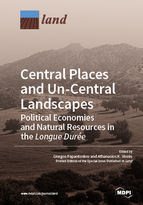Central Places and Un-Central Landscapes: Political Economies and Natural Resources in the Longue Durée
A special issue of Land (ISSN 2073-445X).
Deadline for manuscript submissions: closed (1 September 2018) | Viewed by 89114
Special Issue Editors
Interests: ancient Cyprus; Mediterranean archaeology; archaeological theory and methods; landscape archaeology; the archaeology of ritual and religion; ancient art, iconography and artefact studies (with emphasis on sculpture and terracotta figurines); Hellenistic portraiture and Hellenistic ruler image-making
Interests: landscape archaeology and archaeological survey; settlement archaeology; sacred landscapes; the transition from polytheism to Christianity (4th–6th century AD); the transition from Late Antiquity to the Early Middle Ages (7th–9th c. AD); Identity in Byzantine art and material culture (social, religious, ethnic); Byzantine everyday life through the sources (texts—pictorial evidence—material culture); the history and archaeology of food consumption; technology/production—distribution—use of Byzantine and post-Byzantine ceramic vessels
Special Issue Information
Dear Colleagues,
This Special Issue aims to rethink and reevaluate the Central Place Theory in light of contemporary developments in settlement archaeology, methods and archaeological thought by bringing together ‘central places’ and ‘un-central landscapes’ and grasping diachronically upon the complex relation between town and country, as shaped by political economies and the availability of natural resources. The chronological range of the volume is open, ranging from prehistory to the recent past.
Micro-environments with natural boundaries (e.g., rivers, mountains, woods) and desirable resources (e.g., water, arable land, minerals) sustained nucleated communities and remained occupied for almost every period. On the other hand, ‘central persons’ may be as important as ‘central place’ and this is where the concept of political economy evolves. As T. Earle has eloquently argued on several occasions, all economic theories should recognize that, to whatever degree realized, power strategies were built on economic and ideological control over resources.
Landscape archaeology is an area of study that overcomes the conventional boundaries between disciplines, such as anthropology, history and geography, and provides a fresh perspective and a powerful investigative tool to address research questions related to the conscious and the unconscious shaping of the land and the processes of organizing space, involving interaction between the physical environment and human presence. Temporality, spatiality, materiality and site-based analysis are all encompassed in the concept of landscapes, and therefore through its study much can be said about human responses to the changing conditions of life in the longue durée (i.e. the long term history).
The volume wishes to include papers addressing ‘central places’ and/or ‘un-central landscapes’ from a political economy or/and a natural resources perspective. Moving away from model-bounded approaches, Central Place Theory is used more flexibly to include all the places that may have functioned as places of economic or ideological centrality (even in a local context) in the past, including urban centers, agro-towns, countryside settlements, burial and ritual topoi. The diversity of the different disciplinary perspectives and approaches, combined with dialogues, enriches our task of multiple interpretations, and should be seen as a healthy pluralism.
References
- Citter, C. Landscapes, settlements and sustainability. In Handbook of Landscape Archaeology, PCA Studies 2; Chavarria, A. Reynolds, A. Eds., SAP: Mantova, Italy, 2015; pp. 253–272.
- Collar, A.; Coward, F.; Brughmans, T; Mills, B.J. Networks in archaeology: Phenomena, abstraction, representation. J. Archaeol. Method Theory 2015, 22, 1–32.
- Christaller, W. Central Places in Southern Germany. Prentice-Hall: Englewood Cliffs, NJ, USA, 1966.
- Earle, T. How Chiefs Come to Power. Stanford University Press: Stanford, CA, USA; 1997.
- Earle, T. An Essay on Political Economies in Prehistory. Habelt-Verlag: Bonn, Germany, 2017.
- Feinman, G.M.; Garraty, C.P. Preindustrial markets and marketing: Archaeological perspectives. Annu. Rev. Anthropol. 2010, 39, 167–191.
- Hanson, J.W. An Urban Geography of the Roman World, 100 BC to AD 300 (Archaeopress Roman Archaeology 18); Archaeopress Publishing Ltd: Oxford, UK, 2016
- Jiménez, M.J.; Garcia, C.T. Central places in the post-Roman Mediterranean: Regional models for the Iberian Peninsula. J. Mediterr. Archaeol. 2015, 28, 81–103.
- Koder, J. Land use and settlement: Theoretical approaches. In General Issues in the Study of Medieval Logistics. Sources, Problems and Methodologies; Haldon, J.F. Ed.; Brill Academic Pub: Leiden, The Netherlands, 2006; pp. 159–183.
- Lösch, A. The Economics of Location. Yale University Press: New Haven, London,1954.
Dr. Athanasios Vionis
Guest Editors
Manuscript Submission Information
Manuscripts should be submitted online at www.mdpi.com by registering and logging in to this website. Once you are registered, click here to go to the submission form. Manuscripts can be submitted until the deadline. All submissions that pass pre-check are peer-reviewed. Accepted papers will be published continuously in the journal (as soon as accepted) and will be listed together on the special issue website. Research articles, review articles as well as short communications are invited. For planned papers, a title and short abstract (about 100 words) can be sent to the Editorial Office for announcement on this website.
Submitted manuscripts should not have been published previously, nor be under consideration for publication elsewhere (except conference proceedings papers). All manuscripts are thoroughly refereed through a single-blind peer-review process. A guide for authors and other relevant information for submission of manuscripts is available on the Instructions for Authors page. Land is an international peer-reviewed open access monthly journal published by MDPI.
Please visit the Instructions for Authors page before submitting a manuscript. The Article Processing Charge (APC) for publication in this open access journal is 2600 CHF (Swiss Francs). Submitted papers should be well formatted and use good English. Authors may use MDPI's English editing service prior to publication or during author revisions.
Keywords
- Landscape Archaeology
- Environment
- Natural Resources
- Central Places
- Settlement Systems
- Historical Geography
- Political Economy
- Diachroneity






